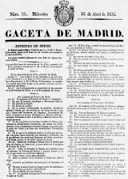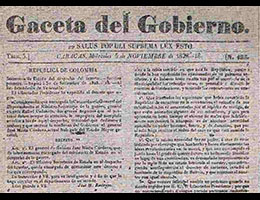 The concept of gazette can come from two different etymological sources: the Italian gazzetta or the French cassette . In the first case, the term refers to a periodical publication , while in the second case it refers to a refractory box .
The concept of gazette can come from two different etymological sources: the Italian gazzetta or the French cassette . In the first case, the term refers to a periodical publication , while in the second case it refers to a refractory box .
A gazette, therefore, can be a daily or weekly newspaper where administrative, commercial or other news is announced. The origins of the notion are found in a newspaper that emerged at the beginning of the 17th century in Venice , and then came to refer to any type of publication that is presented with a certain periodicity.
In the 7th century, Venice was considered the most important point of European negotiations regarding the political sphere. The original name of the gazette derives from the fact that it received a copper coin with which each copy of this type of publication could be purchased.
It is important to note that the original idea of the gazette did not arise in Italy but, like many other creations, was born in China. There they had been publishing news in this format for a long time, which also included the complete list of punishments and graces that the emperor imposed or granted to his vassals.
Just as other European countries were quick to adopt the idea brought by the Venetians from China, little by little this spread to the rest of the world. One of the main changes that the gazette went through over the years was the increase in the frequency with which it was published, until it reached a daily periodicity, which led to the emergence of the name "daily" to designate this format in some countries.
It can be said that gazette is synonymous with newspaper or even newspaper. Throughout history, however, many publications bore the specific name of gazette.
The first French gazettes, for example, were published in 1631 under the direction of Teofastro Renaudot , a medical professional. About three decades later, gazettes dedicated to literature emerged in France.
In Spain there was the Gaceta de Madrid , a weekly publication in which the government disseminated official information. It appeared in the mid-17th century and was sold weekly; Each issue offered news both nationally and from the rest of the world across its four pages. Over the years, the Madrid Gazette became the Official State Gazette .
 At first, the purpose of the Madrid Gazette was to publish the decrees, regulations and laws of the executive branch, the central offices and the Supreme Courts, as well as other resolutions and provisions. The authorities of the time gave the reading of this information a mandatory nature given that it was an official government body.
At first, the purpose of the Madrid Gazette was to publish the decrees, regulations and laws of the executive branch, the central offices and the Supreme Courts, as well as other resolutions and provisions. The authorities of the time gave the reading of this information a mandatory nature given that it was an official government body.
La Gaceta de Buenos Aires , on the other hand, was the first newspaper to be printed in Argentina . Published between 1810 and 1821 , it was created to disseminate the decrees and official resolutions of the First Government Board , as well as general news. Its main promoter was Mariano Moreno .
The Gazette of Mexico and the Gazette of Guatemala were other informational organs of the authorities that, centuries ago, were published on the American continent. The first Mexican gazette was published in 1722, when the country was still known as New Spain.s
The refractory gazette , on the other hand, is a container that is used inside the oven to protect the pieces while they are being cooked. Its purpose is to preserve the whiteness of the ceramic or porcelain, isolating the pieces from direct fire, ashes and smoke.
